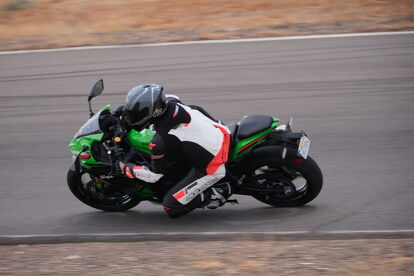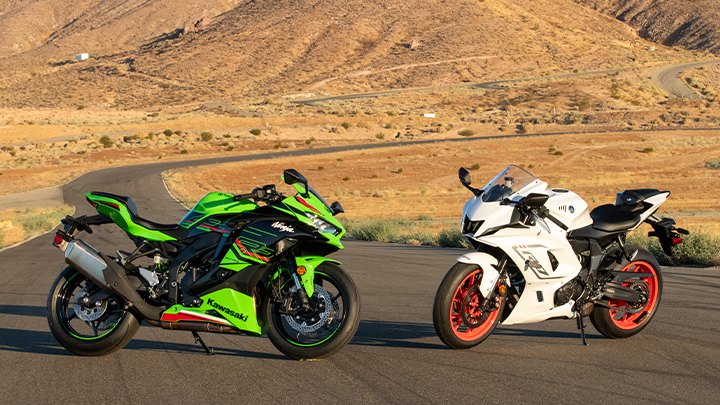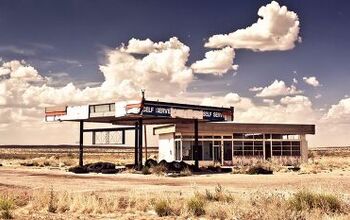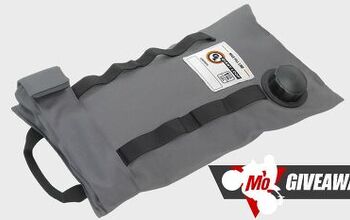Uncorked! 2023 Kawasaki ZX-4RR Vs Yamaha R7 – On Track

ECU flashing takes two vastly different motorcycles to the same place. But who does it better?
There’s a saying in combat sports that styles make fights. Dominant fighters can sometimes be put on their hands and knees by someone with a style they aren’t prepared to defend. Other times the fans are treated to a show because the favorite has to adapt to a fighter with an unorthodox technique. Ali vs. Frazier became legendary because not only were the two complete opposites in the ring, but they were opposites out of it, too. In more modern times, Tyson Fury became the current heavyweight champion by using skill and agility to beat Deontay Wilder, a fighter who uses his ridiculous punching power to clobber his opponents – while also making up for his relative lack of experience with the Sweet Science.
ECU Flashed 2023 Kawasaki ZX-4RR vs Yamaha R7 – On Track
An unlocked Kawasaki ZX-4RR going up against an equally unlocked Yamaha R7 is the comparison we all wanted to see, and the two bikes reach the same point in very different ways.
Kawasaki ZX-4RR (after ECU flash)
Highs
- 70 horses from a 400cc engine is impressive
- Autoblipper is a must-have
- Perimeter frame provides better lateral rigidity
- You don’t really need an electronics suite, but it’s nice to have
- We’ve only just scratched the surface of performance potential
Sighs
- Low ground clearance
- Suspension is mediocre
- Not a lot of room to move around in cockpit
- Upshifts are a little notchy
- Steel lines and a better master cylinder would be a huge improvement
Yamaha R7 (after ECU flash)
Highs
- Torque monster by comparison
- Flat torque curve = easy bike to ride
- Ergonomics are well suited for track riding
- Great braking power from the Brembo radial master
Sighs
- Runs out of steam up top
- No autoblipper for downshifts
- LCD gauges are kinda lame now
- ABS kicks in too early (to be fair, so does the Kawasaki’s)
A complete contrast of styles is exactly what we have here between the Kawasaki ZX-4RR and Yamaha R7. Kawasaki’s genre-bending 400cc four-cylinder sportbike is not only a throwback to the 1990s, but it’s also a clever reminder that entry-middleweight sportbikes don’t have to be relatively boring parallel-Twins with low rev ceilings. With the ZX-4RR, you have a machine that’s approachable to both novices and experienced riders alike, one that’s ready to excite you as it screams past 16,000 rpm.
Or at least it should. In stock trim, the little four-banger is restricted and doesn’t make much power past 11,500 rpm. Who wants to ride a bike that’s choked up like that? We certainly didn’t, and neither do most people. It seems like within days of the bike’s release I had seen videos of owners and tuning shops with unrestricted 4RRs making 70 horsepower – putting it in the ballpark of middleweight Twins.
With that number in mind, it seemed to me like the Kawasaki was punching way above the current crop of entry-level sportbikes and needed to be compared to something bigger. It just seemed obvious that the R7, and bikes like it, were its natural competitor. Various comments found around the internet agreed – and now here we are.
A Test With A Twist
Normally in tests like these, we ride the bikes in stock form, just how they come off the showroom floor. But to assume anyone serious about the Kawasaki (or Yamaha, for that matter) is going to leave it restricted would just be fooling ourselves. That’s why we approached Graves Motorsports to help us with our ZX-4RR test bike. As Kawasaki’s contracted tuning house, Graves has been on the forefront of ZX-4RR development, including what we consider the first thing any US-based ZX-4RR owner should do to their bike – ECU flashing.
The exact details of what an ECU flash entails is the secret sauce of any tuning company, so naturally those things are closely guarded. However, it’s safe to say that the ZX-4RR throttle plates are now allowed to open fully – and stay open – past the stock restriction of 11,500 rpm, all the way to its 16,000-ish rpm redline. Without making any other changes, that alone unlocks a ton of power. Naturally, adding other mods like an exhaust or velocity stacks would open the Kawi’s potential even more. In speaking with some tuners, it sounds like 90 reliable horsepower is possible. If you’re willing to live on the knife edge, getting to triple digits is also in the cards. All from 400cc!
However, flashing comes at a cost beyond the $350 Chuck charges. With the EPA clamping down on aftermarket tuners who skirt around emissions regulations, it’s more important now to reiterate that the Graves ECU flash is for off-road use only. Meaning, technically, your bike isn’t street legal with the flash. We’re not blind to the fact that many people are going to run a flash on the street anyway, but you run the risk of serious penalties and/or fines not just for yourself, but also for the tuning house if you get caught. For this and other reasons, like a low-torque, high-revving 400 being a less-than-optimal street bike, we’re keeping this test track-focused. Which is where both of these bikes shine anyway.
In the interest of fairness, Graves also flashed the R7’s ECU, though it didn’t benefit nearly as much as the Kawasaki (see dyno chart above). We suspect the reason is because the Kawasaki is electronically limited, whereas the Yamaha is mechanically limited – meaning the R7 needs internal engine work to really see power gains. And while we originally pitted this duo together because of their power similarities, the Yamaha and Kawasaki are a lot closer matched than we thought.
For starters, both bikes make similar power and weigh exactly the same – 414lbs, according to the respective manufacturers. When we look at the all-important geometry numbers, we see more similarities. The Kawasaki’s rake and trail measure 23.5º/3.8 in. compared to the Yamaha’s 23.7º/3.5 in. At 54.9 inches, the R7’s wheelbase is slightly longer than the ZX’s 54.3 inches. Next, there’s the $500 price difference. At $9,699, the smaller-engined Kawasaki is the more expensive bike.
However, the extra $500 does get you some tangible benefits over the Yamaha, like a 4.3-inch TFT display, traction control, up-and-down quickshifter (it’s only up on the R7), power modes, and even smartphone connectivity.
Getting Down To Business
So, what’s it going to be? Will the four-cylinder screamer get the edge on track, or will the smooth torque and useable power of Yamaha’s CP2 Twin get the jump on corner exits and hold off its rival? These are the kind of style differences that make tests interesting, and the tight Streets of Willow racetrack is the perfect venue to highlight both bike’s strengths and weaknesses.
For this test we joined our friends at Compact Octane, a new trackday upstart in the SoCal region, at the Streets of Willow racetrack adjacent to Willow Springs. After its founder, a small-bike enthusiast and Yamaha R3 owner, found himself getting smoked in the straights by literbikes, only to pass them back in the corners, he thought he’d start his own trackday catering to 400cc bikes and smaller. An Open class was added to this day for bikes of all sizes, which allowed the R7 to play (and to recoup some of the trackday costs), but the heart lies within the little bike ranks – and it’s a really great time.
Dunlop also supported this test, providing its Q5 trackday tire for both bikes, leveling the playing field and giving neither bike a tire advantage. We normally use a control tire when conducting track tests, and for this test we really didn’t want to mess with tire warmers and the extra hassle they involve. At least at the time of our test, the Q5 was the only trackday tire available in both bike’s rear tire sizes – 180/55-17 for the Yamaha and 160/60-17 for the Kawi. Both bikes use the super common 120/70-17 front.
Styles really do make fights, or comparison tests in this case, and that’s evident when riding the Kawasaki after doing a session on the Yamaha. The R7 is easy to get used to, with its broad, usable torque. You get up to speed quickly, and though the quickshifter is a little notchy, it’s still a benefit.
Having not ridden a ZX-4RR before, the lack of torque surprised me. There’s nothing there. It’s the exact opposite of the R7. If this were a street test, that would be all I really needed to know about which would be the easier one to live with on the roads. However, being a track test the mentality shifts a little.
Once you get those four little pistons spinning past 12,000 rpm, the Kawasaki comes alive. It’s a complete contrast in riding styles; the Kawi is happiest when it’s screaming its head off while the Yamaha prefers to use its grunt. To keep the ZX on the boil means lots of shifting. Thankfully, the autoblipper up and down is a big benefit. Like the Yamaha, upshifts could be cleaner, but I was happy with how well the system matches revs on downshifts. Even when clicking into first gear without the clutch.
Following the Kawasaki while on the R7, I could gain an advantage driving out of corners and latch on to the 4RR’s tail, but the ZX’s slight horsepower advantage starts to kick in right when the Yamaha runs out of steam, giving it the ability to keep the R7 at arm’s reach – but only just.
Style differences go beyond the engine characteristics. Ergonomics are an underappreciated difference, too. You sit more on top of the Yamaha rather than inside it, like you do with the Kawi. The R7’s clip-ons that are level, or even slightly below, the triple further puts you in the commanding and sporty posture. Not only are you sitting inside the ZX, but the clip-ons rise above the triple and the pegs are a little lower, too. You’re still in a sporty stance, but the R7 is clearly trying harder to emulate the original R7 from 20 years ago.
Having spent lots of time with the R7 in the past there was little acclimation time needed before getting down to business. Maybe I’ve been spending too much time on naked bikes with handlebars lately, but since neither bike is equipped with great suspension, I needed to balance finesse when the chassis was working with brute force when it wasn’t. The R7’s lower bars allowed me to be smoother during times of finesse, but the Kawi’s bars worked better when it was time to tell the bike where to go.
To that end, better suspension would be the second modification I’d do to both bikes. Both are damped on the softer end for my 160-ish pounds, but by virtue of having more adjustability with front preload and rear compression and rebound, you can fine tune the Kawasaki to better suit the conditions. To a degree. The non-adjustable fork on the R7 can be a limiting factor in how hard you can push the front, but it becomes less so when you need to ride in a certain way to limit ABS intervention. That means braking earlier and longer and avoiding the ABS. The byproduct of that is less of a load on the front end. It’s certainly not the best way to navigate around a racetrack, but it does let you trail brake fairly deep into a corner. All of that is to say you can push the Kawasaki’s front end a little more than the Yamaha – but ABS on both bikes limits how much you can really dig the front end in the ground.
It’s ironic, then, that the R7’s Brembo radial master cylinder provides immensely better lever feel than the Kawasaki’s generic axial master. However, once the ZX’s pads do start to bite, they provide stronger braking power than the Yamaha’s. So it’s a tradeoff; better lever feel but less power from the R7, or a spongy lever but more bite from the 4RR?
Lap Time Comparison
Lap time comparisons at a crowded trackday are tricky because they don't come close to telling the whole story. With hardly a clean lap on either bike throughout the day, you don’t really know their true potential. However, what good is a track test between two very different motorcycles without some lap times to argue over? So, here goes.
With its considerable torque advantage but top-end limits, the R7 pulled consistent 1:27 lap times. The Kawasaki meanwhile, with its gutless bottom end but better top-end rush, could get around the track a second faster, pulling multiple 1:26 lap times. To be clear, both bikes could have gone faster with open space in front of us, but this still gives us valuable information. As long as you can keep the ZX-4RR spinning, it can move at a pace the R7 will have to work harder to achieve. This despite the fact the pegs occasionally touched down on the Kawasaki.
The beauty here is that both bikes have a lot of room to improve with aftermarket help. One only needs to look at the MotoAmerica Twins Cup series to see how far the R7 can be modified (100 horsepower versions are not unheard of). Obviously, the ZX-4RR is very early in its development, but it’s plausible that similar performance is possible. This likely puts MotoAmerica in a tough spot as they decide what to do with the ZX-4RR, though it seems to us like MA should simply change the name of the class and let the bike in. Thankfully, this isn’t our problem.
Is there a winner and loser here? As usual with these things, it depends. The Kawasaki shows a lot of potential – assuming the track is where you plan to spend most of your time. On the street it seems hugely impractical to keep the engine spinning to the stratosphere – and that assumes you’ve accepted the possible consequences of running with an illegal ECU flash. If street riding were the primary use case, I’m picking the R7. Easy.
On the track I’m not so sure, and it really does come down to two different styles. We’ve already seen what the aftermarket can do to an R7. As someone who likes to fiddle and modify my bikes, being the flavor of the moment, the potential of the ZX-4RR platform has me excited to see what else is in store. If a simple ECU flash is enough to ward off the Yamaha, a ZX with proper suspension, higher footpegs, and more power adders has all the makings for a really spicy track bike.
Troy's Gear

- Helmet: 6D ATS-1R Alpha Helmet
- Suit: Alpinestars GP Force Chaser
- Airbag: Alpinestars Tech-Air 5
- Gloves: Alpinestars GP Tech v2 Gloves
- Boots: Alpinestars Supertech R Vented Boots
ECU Flash Kawasaki ZX-4RR vs Yamaha R7 Spec Sheet | ||
|---|---|---|
Kawasaki ZX-4RR | Yamaha YZF-R7 | |
MSRP | $9,699.00 | $9,199.00 |
Engine | ||
Type | 399cc 4-Stroke, Liquid-Cooled, DOHC, 4 Valves Per Cylinder, Inline 4 | 689cc liquid-cooled, 4-stroke, DOHC inline twin-cylinder; 4-valves per cylinder |
Bore and Stroke | 57.0 x 39.1 mm | 80.0mm x 68.6mm |
Fuel System | DFI w/34mm Throttle Bodies(4) | Fuel injection |
Compression Ratio | 12.6:1 | 11.5:1 |
Horsepower (measured) | 68.5 @ 15,000 rpm | 64.4 hp @ 8700 rpm |
Torque (measured) | 24.9 lb-ft @ 12,200 rpm | 44.6 lb-ft @ 6400 rpm |
Drive Train | ||
Transmission | 6-speed KQS with Positive Neutral Finder | 6-speed; multiplate wet clutch; with Assist & Slipper clutch |
Final Drive | Sealed Chain | Chain |
Suspension/Brakes | ||
Front Suspension | 37 mm Inverted SFF-BP Fork with Adjustable Preload and Top-out Springs | Telescopic fork; 5.1-in travel, adjustable for preload, rebound and compression |
Rear Suspension | Horizontal Back-link with BFRC lite Shock with Piggyback Reservoir, Adjustable Preload, Compression, and Rebound Damping, Top-out Springs | Linked-type Monocross shock, adjustable preload and rebound; 5.1-in travel |
Front Brake | Dual Semi-floating 290 mm Discs with Radial-mount, Monobloc Opposed 4-Piston Calipers | Dual radial-mounted calipers, 298mm hydraulic disc, Brembo master cylinder |
Rear Brake | Single 220 mm Disc with Single-Piston Caliper | 245mm hydraulic disc |
Front Tire | 120/70-17 | 120/70ZR17 |
Rear Tire | 160/60-17 | 180/55ZR17 |
Dimensions | ||
Rake/Trail | 23.5° / 3.8 in. | 23°40′ / 3.5 in. |
Wheelbase | 54.3 inches | 54.9 inches |
Seat Height | 31.5 in. | 32.9 in. |
Curb Weight | 414.5 pounds (Claimed) | 414 lbs. (claimed) |
Fuel Capacity | 3.96 gal. | 3.4 gal. |
Warranty | 12 months | 1 Year (Limited Factory Warranty) |
We are committed to finding, researching, and recommending the best products. We earn commissions from purchases you make using the retail links in our product reviews. Learn more about how this works.
Become a Motorcycle.com insider. Get the latest motorcycle news first by subscribing to our newsletter here.

Troy's been riding motorcycles and writing about them since 2006, getting his start at Rider Magazine. From there, he moved to Sport Rider Magazine before finally landing at Motorcycle.com in 2011. A lifelong gearhead who didn't fully immerse himself in motorcycles until his teenage years, Troy's interests have always been in technology, performance, and going fast. Naturally, racing was the perfect avenue to combine all three. Troy has been racing nearly as long as he's been riding and has competed at the AMA national level. He's also won multiple club races throughout the country, culminating in a Utah Sport Bike Association championship in 2011. He has been invited as a guest instructor for the Yamaha Champions Riding School, and when he's not out riding, he's either wrenching on bikes or watching MotoGP.
More by Troy Siahaan


























































































Comments
Join the conversation
I wear Team Green and will be attending a local demo ride in a couple weeks; however, if given the choice I would take the Yamaha even with the continued use of color painted wheels. At least they are not blue!
Great read, I loved the article! Middleweight bikes are exciting and the Kawasaki is especially intriguing but it won’t be available where I live unfortunately. It’d be great if you could do a follow-up to this article where you update the suspension…
Edit: It was bittersweet to see Evans Brasfield’s response right after I posted my response, hence my edit. I thought perhaps I should delete my comment but I then decided to keep it hoping he would’ve been pleased to read it. Motorcycle.com always has a special place in my heart since I started following it way back in ‘95 and it was always nice to see Evans and read his articles here. May he rest in peace…